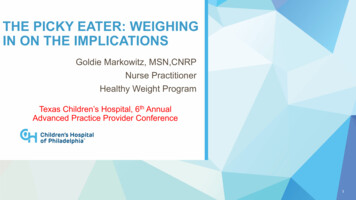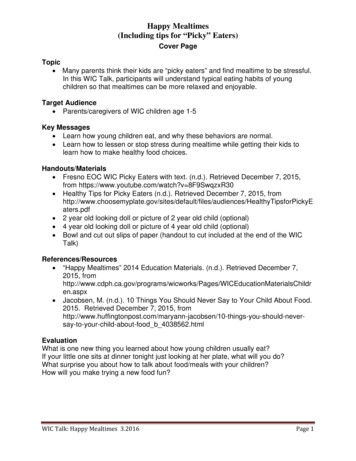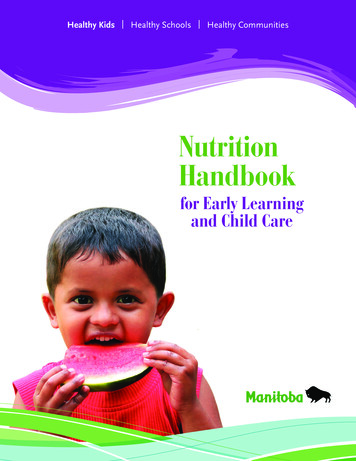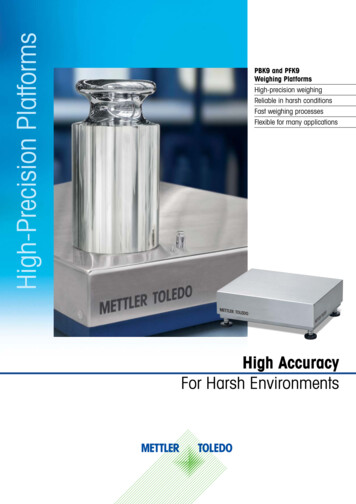
Transcription
THE PICKY EATER: WEIGHINGIN ON THE IMPLICATIONSGoldie Markowitz, MSN,CNRPNurse PractitionerHealthy Weight ProgramTexas Children’s Hospital, 6th AnnualAdvanced Practice Provider Conference1
THANKS TO TEXAS CHILDREN'S HOSPITAL
DISCLOSURES I do not have any financial interests or conflicts to report
OBJECTIVES Recognize when a child is more than “a picky eater“ Describe the risk factors for developing disordered eating Compare and contract treatment strategies for the child withfeeding/eating issue and abnormal weight: underweight oroverweight Identify long term consequences4
THE FACES OF WEIGHT ISSUES5
FEEDING/EATING ISSUEMalnutritionFeeding DisorderObesityPicky Eater6
PREVALENCE OF PICKY EATING Parents report picky eating: 8% to 50% 19% at 4 months 50% at 24 months No universal definition of a picky eater Picky eating is described: Limited variety independent of nutritional statusRefusal to eat a nutritionally adequate dietTotal refusal of certain foods or food groupsFailure to meet parents expectations for varietyCarruth, D. et al, JADA, 2004, Trafholtz, et. al, 20177
DEVELOPMENT OF PICKY EATINGAntecedent-Behavior-Consequence (ABC)Antecedent: demand to eatBehavior: child refuses, cries, screams, hits, gets out of chairConsequence: child gets out of eating the food8
CONSEQUENCE: FAMILY Frustration and resentfulness toward child Sibling relationship disruption Role modeling negative behaviors to other siblings Impaired family social interactions Dining out, other social opportunities hindered9
GENERAL STRATEGIES: DO Establish consistent mealtime routine Limit meals to 30 minutes Offer new food 8 -10 times Positive role modeling Encourage independent feeding Serve age-appropriate food Child-appropriate equipment10
GENERAL STRATEGIES: DO NOT Short order cook Allow grazing Empty calories between meals Give attention to negative behaviors Allow access distractions during meals11
RISK FACTORS: CHILD Nutrition Failure to thrive, underweight, overweightFailure to ingest age appropriate calories or nutrientsDrop or increase in 2 percentilesPlateau on growth curve Delayed progression of oral feeding skills (textures, variety,liquids) Poor/variable appetite; early satiety Sensory food aversion (ASD)12
RISK FACTORS: FAMILY Limited food availability Limited parental problem-solving skills Mental health problems Feeding style & child temperament Knowledge (high chair, food, skill level, portion) Role modeling Cultural influence13
DIAGNOSIS FEEDING DISORDERSAvoidant/Restrictive Food Intake Disorder (ARFID)Persistent disturbance in eating that leads to: Weight loss or inadequate growth Significant nutritional deficiency Dependence on enteral or oral nutritionalsupplements Impaired psychosocial functioninghttp://www.dsm5.org
PREVALENCE OF FEEDING DISORDER25-35 % in typically developing children40-80 % in developmental disabilitiesRamasamy, M, Perman, J., 2000Twatchman-Reilly,J., et al, 200815
PREVALENCE OF OBESITY Rates of obesity in 6-11 year old TRIPLED over past 30years (6% à20%) Prevalence of obesity in 2011-2014 was 17.0% Extreme obesity was 5.8% 30% of children with Autism are ObeseOgden, JAMA, 2016Baio, MMWR, 2018Philips, Maternal and Child Health, 2014Zablotsky, CDC 2015
AUTISM Need for sameness, routine makes transition to feeding moredifficult Impairment in learning consequences of behavior or appetitechanges Reduced responsiveness to social approval Intensity of refusal behaviors (rage) Occurs with first concerns about child17
ASSESSMENT18
FAMILY HISTORY Eating Disorder Obesity Cardiovascular Disease High Blood Pressure Stroke High Cholesterol High Triglycerides Type 1 or 2 Diabetes Liver Disease Bariatric Surgery Polycystic ovarian syndrome
PHYSICAL EXAM Anthropometric: Height, Weight, z-scores, BMI %iles, BP General: dysmorphism, developmental delay, linear growth Skin: hydration, acanthosis, striae, cervical fat pad HEENT: tonsillar hypertrophy CR: murmur, wheeze Abdominal: Hepatomegaly MSK: Range of motion, genu varum, limp, pain, weakness GU: Tanner Stage Swallowing (for young children)
TREATMENT edicalNutrition1. Identify a weight concern2. Prioritize medical and nutritionalneeds as relates to hunger3. Recognize a feeding/eating issue4. Understand family’s willingnessto change behavior5. Develop a shared-decisionmanagement plan21
IDENTIFY A WEIGHT CONCERNBody Mass Index Percentile Ages 2 to 20YearsUnderweightHealthy WeightOverweightObesity 5th percentile5-84th percentile85-94thpercentile95-99thpercentile or BMI 30Severe ObesityBMI 120% of the95th percentile orBMI 35 kg/m2Note: Not all patients with BMI 85% or above have excess adiposity, and many children and adolescentswith BMI 5% are healthy and do not need treatment.The CDC recommends using the WHO growth charts to monitor growth for infants and children ages 0 to 2years of age in the U.S. and using the CDC growth charts for children age 2 years and older.Pediatric Obesity Algorithm . 2018-2020 Obesity Medicine Association.
UNDERWEIGHTDegree of MalnutritionZ-scoreMild-1.0 to -1.99Moderate-2.0 to -2.99Severe -323
BODY MASS INDEX CHARTS FOR CHILDREN WITHSEVERE OBESITY AGES 2-20 YRSUse percent of the 95thpercentile to betterdescribe weightClass 3 Obesity(BMI 40 Adults)Class 2 Obesity(BMI 35-40 Adults)Class I obesity ( 95th percentile to 120% of the 95th percentile)Class 1 Obesity(BMI 30-35Adults)Class II obesity ( 120% to 140% ofthe 95th percentile) or a BMI 35 to 39, whichever lowerClass III obesity ( 140% of the 95thpercentile) or BMI 40, whicheverlower.Pediatric Obesity Algorithm . 2018-2020 Obesity Medicine Association.
MEDICAL elopmentalPediatricsFeedingTeam25
LACK OF HUNGER: CYPROHEPTADINE First generation H1- antihistamine Side effects: increased appetite, sedation, irritability, abd. pain Works by improving with gastric accommodation Dosing: 0.25 mg/kg/day divided BID or TID Recommend cyclingQuestions: When is best time to initiate treatment Duration of therapy
APPETITE STIMULANTS: STRONG EVIDENCEUnderweight, consider med with behavioral approachCyproheptadine 0.25 mg/kg/day divided BID or TIDRecommend cyclingCitationStudy PopulationOutcomeHomnick, D. 2015 Cystic FibrosisAppetite stimulantSant’Anna, A.Feeding problem2014Cuvelier, G., 2014 CancerAppetite StimulantNajib, J., 2014Appetite stimulantUndernourishedchildrenAppetite stimulant
CONSTANT HUNGER Assessment Frequency of asking for foodGrazing vs. scheduled meals or snacksDesperate desire for foodPreoccupation with foodEating when upset or bored Intervention Visual schedule for eatingStructured eating timesDistraction – “what to do instead of snack”Building in breaks before getting snacks/secondsHunger scale
UNDERSTAND WILLINGNESS FOR CHANGE
SHARED DECISION MAKING MODEL Recognize family motivation for change Identify top behavi0rs to change Uses Motivational Interviewing for creating shared planOARS Open ended questionsAffirmationsReflectionsSummaries Reach out to local partners30
DEVEBEHAVIORALLY-BASED STRATEGY nsequenceEatingSwallowingRemaining seatedFeeding selfDiscomfortLimited appetiteDevelopmental disorder/delayDysregulationInconsistent mealtime routineInappropriate food presentationPositive reinforcementRedirectionSocial ModelingEscape prevention
BEHAVIORAL INTERVENTION: EVIDENCE #6AuthorCountrySample sizeShalem, T., etal.2016Hartdoff, C.,etal2015IsraelN 34 ;28 GT depend.Mean age 3.4 yrNetherlandsN 22Ages 9 – 24 mos.Brown, J., etal2014Rudolph,L. ,etal.2013Wiltken, M., etal.2013Silverman, A.,et al.2013USAN 30Mean 3.9 yrUSAN 77Age 2 – 6 yrGermanyN 39Mean 16 mosUSA: WisconsinN 77Mean age 4.5 yearsWright. C., etal.2011EnglandN 41MethodologyLengthOutcomeRetrospective Chart ReviewInpatientAverage 3 weeks85% achieved target goalProspective, cross-overdesign2-week inpatient (study)4-week outpatientRetrospective Chart ReviewBothAverage 4 weeks9 out of 11 weaned in the studygroupInpatientAverage 3 weeksBefore: 69% calories from GTAfter: 90% d/c GTRetrospective Chart ReviewInpatientAverage 2 weeksProspectiveHome-basedAverage 4 to 10 days51% completed weaned by 2weeks and additional 11%within 1 yearWeaned 89.7%FU questionnaires for 2 yearsRetrospective Chart Review prospectiveInpatientAverage 2 weeks51% fully weaned after 2 wksRemainder weaned by 1 yrNutrition maintained 1 yrRetrospective Chart ReviewOutpatientMean 1.7 years78% achieved normal diet17% remained EN2% reliant oral supplement
LOCAL PARTNERSHIPS: COOKING CLASS
LOCAL PARTNERSHIPS : GYM Promote activity Inclusive gym class at school Inclusive afterschool sports Running series (local) Swimming (adaptive class)34
LOCAL PARTNERSHIP: FOOD nerships/
WHEN TO REFER TO SPECIALTY CLINICS Feeding Team, no formal guidelines Losing weight despite interventionsTube-feeding weaningStrategies no longer working/behaviors worseningParent request Weight Management Team, AAP Guidelines Meal replacementMedicationBariatric SurgeryParent request36
CASE STUDY37
CASE PRESENTATION #1Matthew is a 9 year old male with history of Autism and ADHD. Heis a highly selective eater and eats 6 foods. He refuses to drinkmilk or any supplement, but will drink apple juice and Capri Sun.He eats 4 bites before saying he is full. He will refuse food andleave the table and cannot sit still. He is on Ritalin. Weight 3%,BMI 1%. Parents are willing to change (motivation 9/10)
YOUR ASSESSMENT1.2.3.4.5.Weight concern?Is there a medical issue? Is there a nutritional need (hunger)?Is there a feeding/eating issue?Is the family willingness to change?What would be in shared-decision management plan?39
CASE PRESENTATION #2Miguel is a 9 year old male with history of Autism. He is a highlyselective eater and eats 4 foods. He drinks chocolate milk,Pediasure, and soda. He is aggressive and will hit others whentold “no. ” He often raids the refrigerator when everyone issleeping. He can eat a whole loaf of bread at one siting and eats in5 minutes. He is on Abilify. Weight 99%, BMI 99%. Parents donot report willingness to change (motivation 3/10)
YOUR ASSESSMENT1.2.3.4.5.Weight concern?Is there a medical issue? Is there a nutritional need (hunger)?Is there a feeding/eating issue?Is the family willingness to change?What would be in shared-decision management plan?41
WHY FOCUS ON DRUG-INDUCED WEIGHT GAIN?RisksIdentify drugs that cause weightgainBenefitsReplace with drugs thatpromote weight neutrality/loss
CONSEQUENCE FOR DISORDERED EATING Poor/excessive weight gain or growth Delay in development Delay in progression of eating Increase in negative feeding behaviors Poor family relationship Negative experiences around food
AUTISM SPECTRUM DISORDERS ANDMETABOLIC COMPLICATIONS OF OBESITYRetrospective case-control studyMilitary Health BaseN 48,000 Mean age: 8.8 yearsChildren with ASD were 8.2% moreLikely to have Obesity, compared with 4.2%ASD obesity-related issuesMore likely to be prescribed medicationsShedlock, Journal of Pediatrics 2016Prevalence of obesity and metabolic disorders amongchildren with ASD & controls
THANK YOU45
QUESTIONS?
HELPFUL RESOURCES FOR FAMILIES My Plate www.choosemyplate.govAcademy of Nutrition and Dietetics www.eatright.org/kidsChopChop magazine Ellyn Satter, MS, RD, LCSW, BCD Your Child’s Weight: Helping WithoutHarming Jill Castle, MS, RD, CDN FEARLESS FEEDING: How to Raise HealthyEaters from High Chair to High School.
PSYCHOLOGY RESOURCES FOR FAMILIES General Behavior Management Your Defiant Child, Second Edition: eight steps to better behavior by RussellBarkley and Christine Benton The Everyday Parenting Toolkit by Alan Kazdin 1-2-3 Magic: 3-step discipline for calm, effective, and happy parenting byThomas Phelan Selective Eating Broccoli Boot Camp by Keith Williams and Laura Seiverling Overeating/Mindful Eating Getting Over Overeating for Teens by Andrea Wachter Free Your Child from Overeating: A handbook for helping kids and teens byMichelle Maidenberg
PHYSICAL ACTIVITY RESOURCES Exercise apps NFL Play60 NikeTrainingClub Sworkit Computer resources Gonoodle.com – interactive games Darebee.com – workout sheets with pictures Fitnessblender.com – workout videos Community information Most gym facilities do not accommodate children, youth trainingprograms are common but at a high cost YMCAs allow children aged 10 on fitness floor;offer other youththprograms and have a free membership for 7 graders
PREVALENCE OF PICKY EATING Parents report picky eating: 8% to 50% 19% at 4 months 50% at 24 months No universal definition of a picky eater Picky eating is described: Limited variety independent of nutritional status Refusal to eat a nutritionally adequate diet Total refusal of certain foods or food groups










